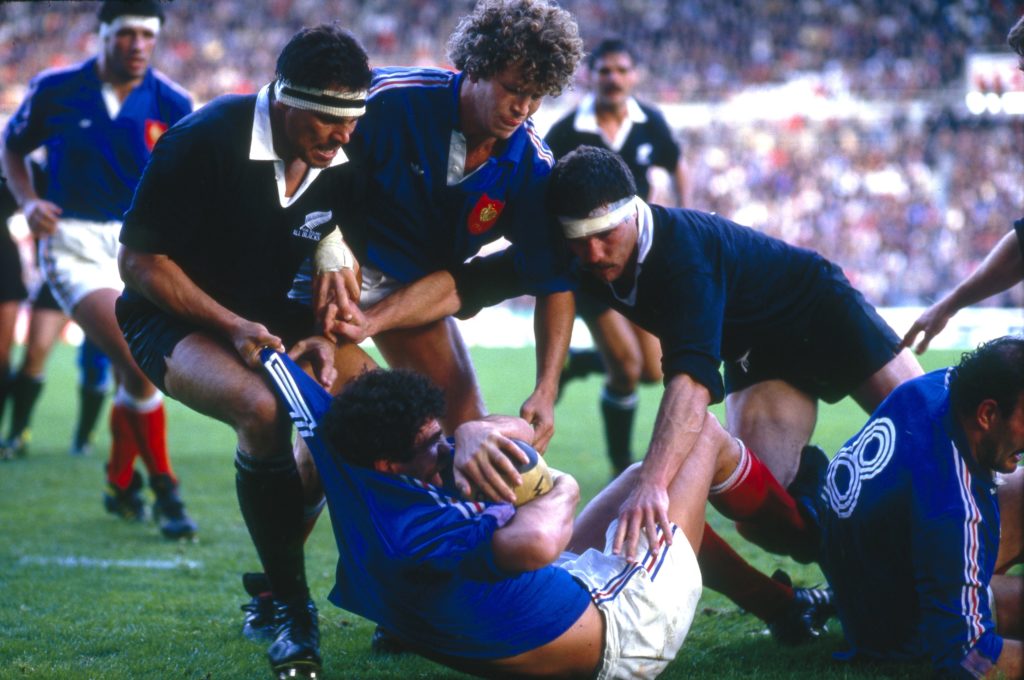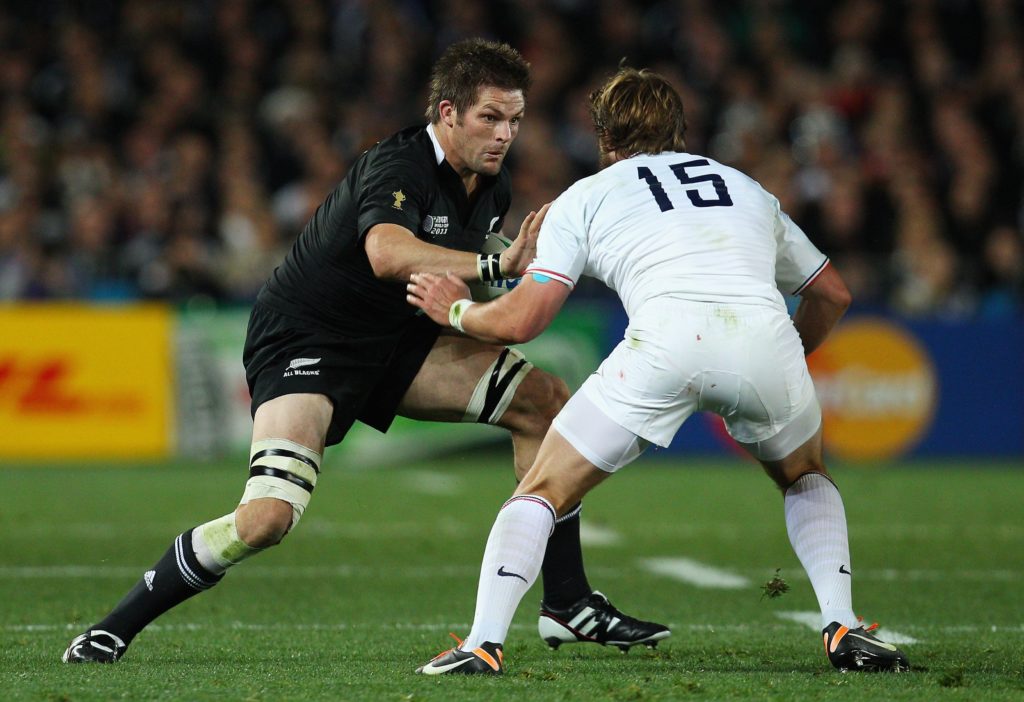In November, Gregor Paul released a new book called The Captain’s Run, exploring what it takes to lead the All Blacks. He has written a four-part series for The XV exploring the qualities the best captains have shared, while also looking into the stories of those who didn’t succeed in the role. Part two looks at the levels of toughness and resilience the captain must show and the trauma through which he must be prepared to play.
No-one actually tells All Blacks captains that they can’t ever leave a game because of injury. They all just seem to know that is part of the gig – an expectation that they demonstrate a toughness that marks them as capable of enduring what nobody else can.
Every nation likes to imagine their rugby captain will be chisel-jawed and heroic, capable of withstanding extremes on the field, but the All Blacks captain has to be just about indestructible. Prepared to play through the pain barrier and find a way to carry on and the stories of All Blacks captains being brave and resilient are legendary.
Colin Meads wasn’t the captain when he played a test in South Africa with a broken arm, but he set the benchmark when he did so in 1970. Since then, All Blacks captains have had to find ways to guts it out through the most extreme duress simply because it’s what everyone has come to expect.
Probably the most famous example of toughness was when Buck Shelford played on despite having a ripped testicle in the infamous Battle of Nantes in 1986. That made worldwide headlines but Shelford wasn’t captain that day and nor would he say was that the toughest moment of his career.
Every nation likes to imagine their rugby captain will be chisel-jawed and heroic, capable of withstanding extremes on the field, but the All Blacks captain has to be just about indestructible.
That actually came in 1989 playing against Ireland in Dublin. This was the test in which the Irish stormed the haka – when the mad-eyed captain Willie Anderson advanced his side towards the All Blacks before he went eye-ball-to-eye-ball with Shelford. It was memorably good theatre and displayed just how fired up the Irish were, who then kicked off and charged like mad men at Shelford who had caught the ball.
Shelford, sensing the mood, stuck his head down and decided to blast into the green shirts with the same sort of intensity with which they were coming at him. More than 30 years later, he is still feeling the impact as he suffered enough nerve damage for a muscle in his shoulder to atrophy and wither into nothing.
“I thought I had broken my neck,” says Shelford. “I got caught in a tackle and it crushed something in my neck. Dave Abercrombie was the physio and he got his fingers into me and he pushed and pushed until the muscle released the nerve and I was okay.

“Today’s era is quite different because you are playing with 23 players. In my day you weren’t. You were playing the whole game and you didn’t give it away for anything. You would play through anything.
“If we broke fingers, you would stay on the field. Tape the bastards up and get on with it. Six or seven stitches…you play on. Concussion…captains wouldn’t let you go off the field. Jock [captain Hobbes] wouldn’t let me off in Nantes when I was concussed. Today Jock would not have done that and nor would I. It was just how leadership was back then.”
The other reason why Shelford refused to leave the field, was the the threat emerging in the form of Zinzan Brooke. Shelford, who had been the first choice No 8 since 1986 and captain since the end of 1987, was constantly reading media stories about the rising talent of Brooke.
And obviously Brooke was buying into this as Shelford, lying in agony at Lansdowne Road, recalled a conversation that two men had before the side departed for Europe.
“In 1989 before we went away on tour, Zinny asked if he could talk to me at the dinner that we were having with our families,” says Shelford. “I thought he wanted to talk to me about signing a contract to play league with Manly so we went down to my room.
“Today’s era is quite different because you are playing with 23 players. In my day you weren’t. You were playing the whole game and you didn’t give it away for anything. You would play through anything.
Buck Shelford on the changing game
“He said to me ‘I have been told by John Hart that I am going to be the No 8 in the test matches’. And I said, ‘Zinny if you are playing well enough and playing better than me then I will stand down’. I thought we will see where this runs. He was playing a different type of game to me and Grizz [Wyllie] liked my game rather than Zinny’s game. Zinny was allowed to do what he wanted in the Auckland team, but Alex wanted a No 8 who was going to carry the ball forward off the back of the scrum. A real tough footballer to get over the gainline, but he [Brooke] was all fancy stuff.
“I love Zinny and he is a great footballer but he didn’t have a great tour at all. He was a great person off the field, but his football wasn’t that great whether he was playing No six or No 8 and he didn’t get that test spot.”
When Fitzpatrick was captain in 1994 he had half his ear bitten off in a scrum by Springbok Johan le Roux. Fitzpatrick didn’t react much other than to remonstrate with referee Brian Stirling. Once he’d received acknowledgement it had actually happened, he calmly had it bandaged so he could continue.
In 1997 Fitzpatrick was stamped in the face by Andre Venter. It was another horrific incident that saw Venter red carded and the All Blacks captain barely react and Fitzpatrick was that guy who could absorb almost anything and not react.

That’s why he managed to play 63 tests consecutively and why Warren Gatland famously never got to play a test when he was the All Blacks reserve hooker.
This need to be resilient and refuse to show pain is now a big, big part of being the All Blacks captain, probably because Richie McCaw took it to another level again when he played through the 2011 World Cup with a broken foot.
He was in agony before the tournament even kicked off as an operation he’d had on his foot earlier in the year had resulted in complications. A screw was rubbing on the bone and ended up re-cracking the foot in three places.
He was barely able to train during because his foot was so swollen he couldn’t get his boot on. He says that in the World Cup semi-final, as he ran back to the changing room at half-time, the adrenaline flow eased and he was hobbling up the tunnel.
Somehow, though, he managed to play at his brilliant best and lead New Zealand to the title. As he wrote in his biography of the 2011 World Cup: “I want to give the impression I’m always going to play, and keep my down times to myself.
This need to be resilient and refuse to show pain is now a big, big part of being the All Blacks captain, probably because Richie McCaw took it to another level again when he played through the 2011 World Cup with a broken foot.
“I’m confident that even if I don’t train at all, I can still go out and perform. I’m going to keep playing on it as long as I can stand up and do my job. I’ve got to be optimistic. And sometimes, towards the end of the week, when the oral anti-inflams and Panadols and a lot of rest have done their work, I can almost convince myself it’s just a soft-tissue injury. ‘Nah, I’ll be fine,’ I keep telling anyone who’ll listen, media, team-mates, coaches, myself. ‘Just can’t train because it’ll get a bit sore, but I’m ready to go. I’m good to go.’ And I am. I believe it.”
Three years after that he played two tests against England with broken ribs. In the game in Hamilton he set up one try by delaying a pass that required him to be hit – in the chest – by two England tacklers just as he released the ball. He took the full brunt on the injured zone and made the perfect pass to set up the try and played the full 80 minutes.

That need to be tough has been picked up on by Kieran Read and Sam Cane. The former played 75 minutes of the 2015 World Cup final with badly damaged ankle ligaments and then a full 80 minutes against Scotland with a bulging disc in his back that required major surgery and a seven-month lay-off.
While the latter broke his neck in Pretoria in 2018 and managed to walk off the field unaided. He required major surgery and an eight-month recovery. That he made it back to play at all was a sign of his hardness as the medical staff said the only reason he hadn’t been paralysed was because his neck was so strong it protected his spinal column from being severed.
“I went to clean out a ruck and at the last second, the guy I was looking to clean out moved and my head made direct contact with his hip and I broke my neck,” Cane said after he returned to play in 2019.
“I don’t look back on it as the worst time of my life. I’m fairly resilient and I usually see the positive side of things so, once I had the news that I’d broken my neck but I was going to be okay, I didn’t get too down on myself. I consider myself lucky that it wasn’t worse.
“From there it was a steady process of rehabilitation, which took nine months. Guys do their knees, their ACL (anterior cruciate ligaments) and that also takes nine months. The difference with my injury was, if it had been a little bit worse, I could’ve lost the use of my legs.
“If I allow myself to stop and think how close I got to that, yeah, that’s certainly a bit scary but I try not to let my mind go to that place.”


Comments
Join free and tell us what you really think!
Sign up for free